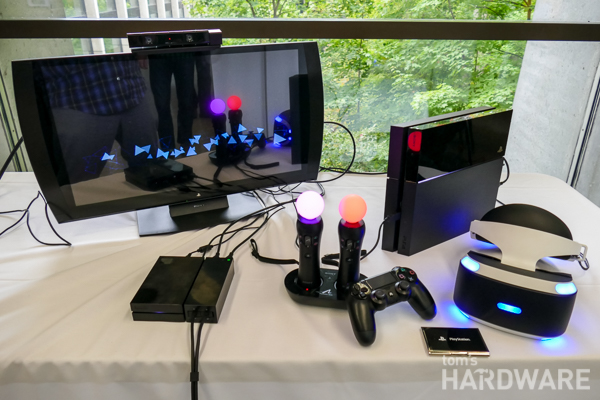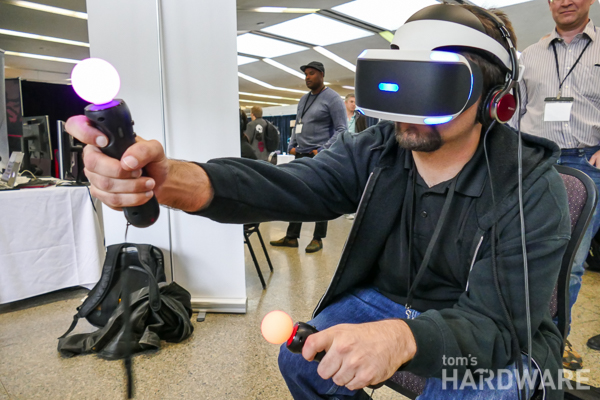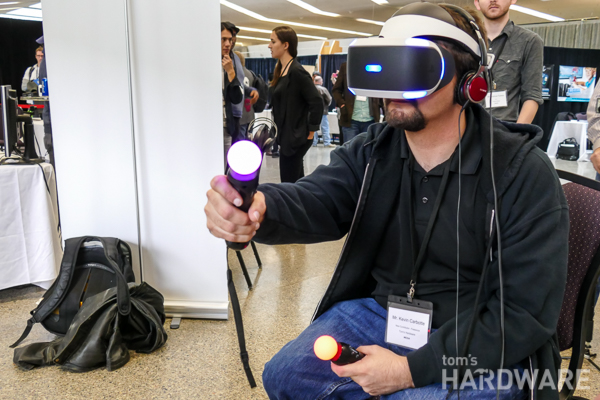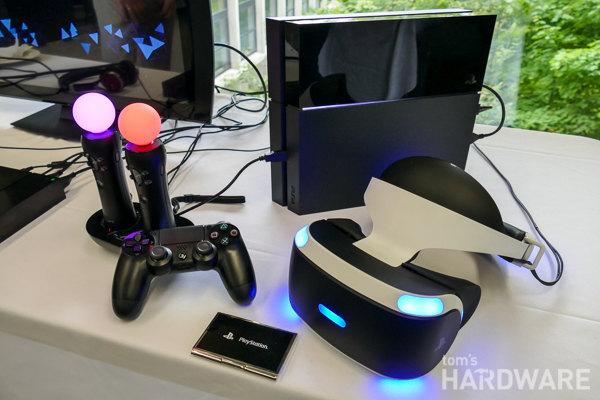Well That Was Impressive: Playstation VR, Hands On

Playstation VR, formerly known as Project Morpheus, is the only VR headset being developed for use with a console. The PSVR HMD will be launching in the first half of 2016 and will connect directly to a Playstation 4.
No Screen Door
If you look at the specs of the headset, you would be forgiven for thinking that the display wouldn't be comparable to the PC HMDs that are just around the corner. Playstation VR boasts the lowest resolution out of all the announced VR HMDs. Unlike the competition from HTC, Oculus and others, the Playstation VR uses a single 1080p display, which is shared between each eye.

Considering the issues that other headsets have had with low resolution (the "screen door" effect), most people would think the problem would be worse on the PSVR. This couldn't be further from the truth. Upon putting the display on my head, I was immediately impressed with the fidelity of what I was looking at. I didn't detect even a hint of "screen door," and the graphics were crisp and clear.
London Heist
Sony was showing off the London Heist demo at Immersed. Back in March, Tom's Hardware's Rexly Peñaflorida II had the chance to try out London Heist, but he was shown a different part of the game. The demo that I got to try has you sitting in the passenger seat of a van being driven by a bald guy. For the first part of the experience, you are just along for the ride. While waiting for the action to start, I was encouraged to explore the cab of the vehicle.
The Playstation Move controllers are tracked very accurately, and a pair of hands are rendered on screen that follow the tracking. It felt surprisingly natural to use the Move controllers to manipulate the objects in the scene. The door can be opened, and you can lean out and look back. The radio can be turned up and the station changed. The glove box opens up, and inside I found several ammo clips, and an empty soda can. I picked up the can and tossed it at the driver's head. It would have been nice if he reacted, but nothing happened.

After a minute or so, the action starts. A barrage of bullets comes crashing through the front window. The driver then passed me an UZI, which I picked up and began to fire at the enemies coming up alongside of us. Attackers pull up on sport bikes and SUVs, and you have to shoot them or the tires to take them out. When the clip runs out, you have to pick up another one with your other hand and slide it into the gun. (Reloading only works once the clip is emptied, so if there's a break in enemies, you'll have to unload your clip on nothing to guarantee a full clip when more vehicles show up.) The demo ends when an armored van pulls out in front and a guy with a chain gun opens the back door and blows you away.
I came away from this experience wholly impressed. Despite the lower resolution, the screen was incredibly clear. I asked how this is possible with a 1080p display, and I was given a response that should have been obvious: Sony has been making cameras for decades and has a great deal of experience developing optics. It's this prowess in optics that enabled Sony to make the image as clear as it is with the display that Playstation VR uses.
Get Tom's Hardware's best news and in-depth reviews, straight to your inbox.
Comfort
The headset itself is quite light and is very well balanced. I was told that the rear section of the strap is weighted to balance the headset. The mechanism the company uses to attach the headset to your head is quite different from the competition, as well. It features a single strap, with an adjustable dial that tightens it. The strap sits at an angle, rather than being level with the headset. This allows the company to balance the headset better. It also features a section that cups your forehead and supports the bulk of the weight.

From the images I've seen of the headset, I expected that it would flip upwards, similar to how the StarVR headset does. This turned out to not be the case, though. Instead of a hinge, the display is on a slider that allows the headset to be moved to accommodate glasses. The person who tried the headset right after me was wearing glasses, and he had no trouble making it fit.
Final Design? Almost?
I asked Sony if the headset being shown would be different from the one released next year. I was told that there will be some minor refinements, but it is largely complete. The cables going to the PSVR headset are likely going to change, though.

As it stands, the way the headset hooks up to the console is quite interesting. Sony has designed a small breakout box that splits the signal to two displays. I was told that the console does the heavy work of warping the image to work properly on the HMD. The warped signal is delivered to the breakout box through one HDMI cable. The received signal is then fed to the PSVR HMD, and then a second signal is unwarped and delivered to the TV. Sony said that this can either mirror the image shown on the display, or it can deliver an entirely different scene to both displays.
I've been rather skeptical of what Sony can really do with the Playstation VR, but I have been converted to a believer. I've had the opportunity to try many VR demos, and honestly, London Heist felt like the best one so far. The experience was tons of fun, and I could see this being a great game. If this is an example of the type of content we'll see on Playstation VR, I think the platform will be very successful. I can't wait to try more.
Update, 10/8/15, 1:20pm PT: After publishing this we learned that in addition to the optics and high refresh rate, the panel used in Playstation VR features three sub-pixels per pixel (RGB) which is not found in other headsets.
Follow Kevin Carbotte @pumcypuhoy. Follow us @tomshardware, on Facebook and on Google+.
Kevin Carbotte is a contributing writer for Tom's Hardware who primarily covers VR and AR hardware. He has been writing for us for more than four years.
-
clonazepam You didn't include any screenshots or video of the actual game(s). Will sharing the VR experience with others be more or less difficult than standard content?Reply
Were the graphics quality somewhere around N64 and Gamecube level of complexity? Did that detract from the experience at all? Did the framerate / frametime feel pretty smooth? -
nitrium I fail to see how the dreaded "screen door" effect can be effectively mitigated by optics - unless they deliberately make the screen fuzzy (there are seriously people that stick sellotape on their Occulus DK2's to do exactly that). Can anyone here explain how optics can reduce/remove the issue of a low resolution screen being viewed extremely close to the your eyes.Reply -
DeadlyDays how is 1080p low resolution?(maybe on a 5 foot wide screen?) and optics manipulate light so can make it appear as if it is farther/closer mitigating any effects of a screen being too close?Reply
And 1080p close to your eyes is pretty high pixel density?
Maybe I am misunderstanding something, seems pretty sweet to me. -
willyardms I think a big reason Playstation VR doesn't have a screen door is the type of screen used. Playstaion VR uses a 1080P RGB while Oculus uses a 1440P pentile.Reply -
TNT27 Well Optics could be as simple as the effect seen with backwards binoculars, it makes the screen appear further away, so you cannot distinguish the different pixels like you could if it appears 1" in front of your face. Which is a great idea, as lower end hardware will be able to perform smoothly, and the user wont be missing out on a clear and crisp VR experience.Reply -
Paranimal The reason they were able to basically eliminate the screen door is by using individual color sub pixels... The OLED in the PSVR is just a better display technology than the Oculus even though the Oculus has a higher resolution. Sony has always been at the front of front of screen tech, going back to the 90s they had the trintron dispays even though they were the same resolution as other TVs the image appeared muchsharper and crisper.Reply -
nitrium ReplyI think a big reason Playstation VR doesn't have a screen door is the type of screen used. Playstaion VR uses a 1080P RGB while Oculus uses a 1440P pentile.
Oh ok. Yes. So if you can put the pixels literally right next to each other without any visible gap, you would obviously not get the "screendoor", rather just something that looks "pixelated" but nonetheless solid (think Minecraft). Which would obviously look a lot better than a screendoor, even if it is of a higher resolution.
I've tried the Oculus DK2 and found the image to be pretty rubbish, so am finding this sort of stuff pretty interesting. -
Vorador2 I still think the future of screens in VR is getting rid of them entirely. No, i'm not talking about directly sending the image to your brain (i wish, but we're likely a hundred years before we manage to do that, barring surprise developments).Reply
I'm talking about virtual retinal display, that uses a laser and micromirrors to project the image directly to the retina. And the technology is almost upon us, with the Avegant Glyph (no VR, just a headmount monitor) supposedly releasing in early 2016. -
GothicVillas as a DK2 owner I read this with an excitement. I love my Rift and enjoy it a lot.. but tbh the image quality is pretty rubbish in the rift. Objects close to you can look great but anything in the distance is a blurry mess. Any menus or any letters are non readable and I end up taking off the headset to read stuff on the monitor next to me. Having said this, VR is still great and I prefer PCars on the rift rather on my triple monitor setup :)Reply
So, reading how good is PSVR makes me wonder...